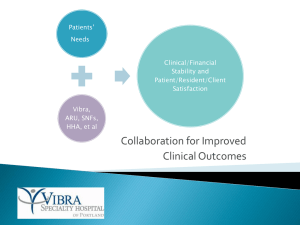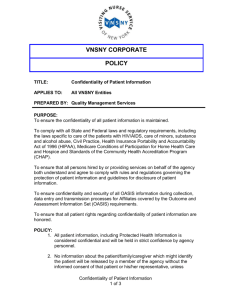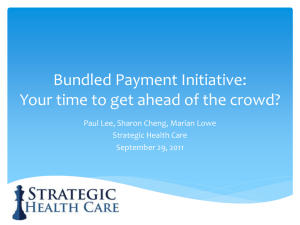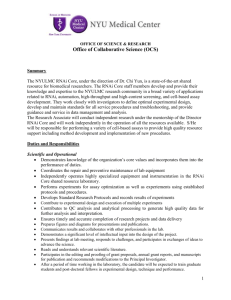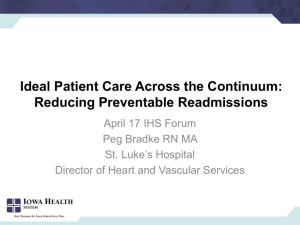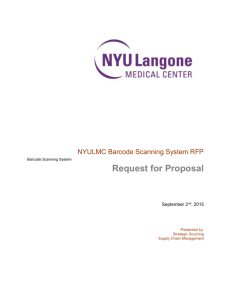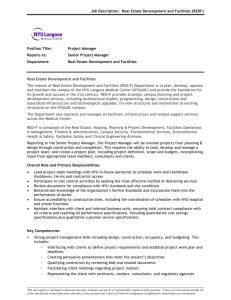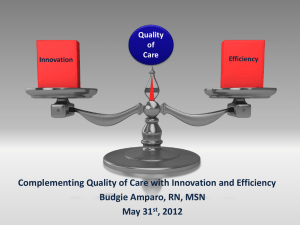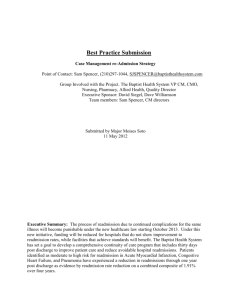Bundled Payment Steering Committee
advertisement
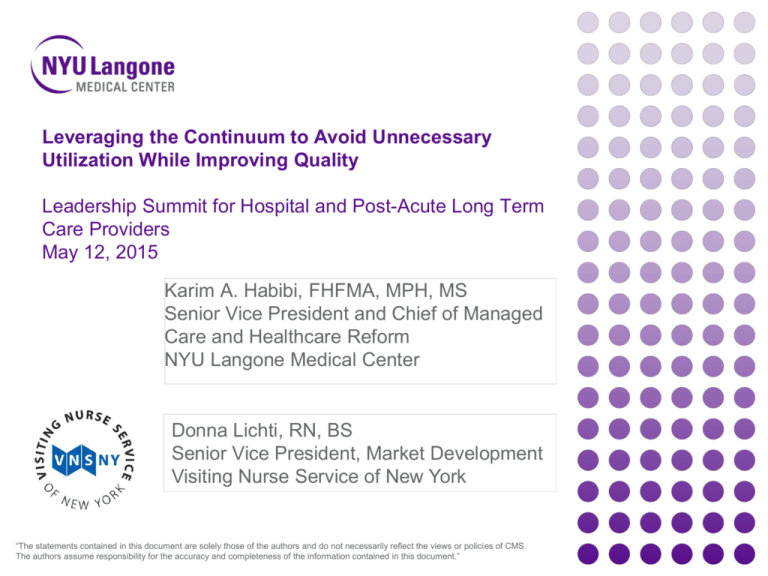
Leveraging the Continuum to Avoid Unnecessary Utilization While Improving Quality Leadership Summit for Hospital and Post-Acute Long Term Care Providers May 12, 2015 Karim A. Habibi, FHFMA, MPH, MS Senior Vice President and Chief of Managed Care and Healthcare Reform NYU Langone Medical Center Donna Lichti, RN, BS Senior Vice President, Market Development Visiting Nurse Service of New York “The statements contained in this document are solely those of the authors and do not necessarily reflect the views or policies of CMS. The authors assume responsibility for the accuracy and completeness of the information contained in this document.” Setting the Stage / Background on NYULMC • Comprised of four hospitals • 1,069 licensed beds • 39,000 patient admissions • 670,000 outpatient visits • Medicare beneficiaries represent 27% of NYULMC volume and 18% of revenue • Established a Clinically-Integrated Network, LLC • 761 voluntary physicians (38%) • 1262 Faculty Group Practice (FGP) physicians (62%) • >1M FGP physician visits 2 Visiting Nurse Service of New York (VNSNY): Innovative home- and community-based models of care for over 120 years 3 Visiting Nurse Service of New York (VNSNY) • Largest not-for-profit home- and communitybased care organization in the U.S. • Range of services across the continuum of care • 17,000 employees • Inter-professional teams serve the most vulnerable and needy • 40,000 members of VNSNY CHOICE health plans • 35,000 patients on any given day 4 Using Model 2 Bundled Payment as an approach to leveraging the continuum of care What is included in Model 2? Any services 72 hours prior to Admission such as… Any services during the Acute Stay such as… Any services during the 90-Day Post-Acute Period such as… Inpatient Rehab Skilled Nursing Facilities & LTACH Home Health Agencies Outpatient Services Hospital PAT Readmissions (to NYU or others) Physician Visits (surgeon and other) ED Visits Consulting Physicians • • • • • Lab Services Surgeon Anesthesiologist Outpatient Services Physician Visits DME Part B Drugs Significant opportunity exists in the post-acute period Attribution is limited to patients that access your facility Providers take accountability for clinical risk without accepting insurance risk Allows building a care coordination infrastructure incrementally Providing information and education to providers across the spectrum, combined with the financial mechanisms to align incentives, is a powerful combination • A targeted focus increases the likelihood of being successful 5 Cost Drivers across an Episode of Care Hospital Acute Care Internal Cost Savings • Reduce LOS or # of visits • Reduce implant, supply, or drug costs • Reduce OR time • Decrease unnecessary tests / pathology Medicare Cost Savings • Reduce facility-based post-acute care • Reduce readmissions • Decrease unnecessary / duplicative utilization • Reduce SNF LOS (paid on per diem) Quality improvements and efficiencies made under the Bundled Payment Initiative benefit all our patients, regardless of payor. 6 Relative Medicare Cost of Episode by Initial Post-acute Setting Total Joint Replacement Initial Post-acute Count Percent 90D 90D AVG 90-Day Episode Setting (n=628) Readmissions Readmission Payment Rate Inpatient Rehab 364 58% 55 15% $40,095 SNF 102 16% 18 18% $43,466 Home Health 136 22% 14 10% $23,462 Outpatient Therapy 22 2% 4 18% $27,267 All post-acute Medicare costs incurred within the 90d bundle are categorized by the initial post-acute setting (i.e., includes readmissions and other levels of care following the initial setting) Data is based on FY 2009 (October 1st, 2008 - September 30th, 2009) 7 Early Lessons Learned from Implementation 8 Clinical Management Throughout the Pathway The Importance of Care Coordination • Enforces best practices / standardization of pathways, workflows, and order sets • Improves communication between providers and to the patient •Ensures follow-up after care transitions •Optimizes Patient Expectations and Outcomes Goal : Develop a pathway with >80% use of all elements with exclusion determined by pathway criteria, not physician preference. 9 Laying the Groundwork for a Successful Implementation Pre-hospital Inpatient Post-discharge • Improved workflows • Interdisciplinary inpatient pathways • Improved communication / handoffs • Improve prediction of discharge setting • Role clarification among care team • Post-acute pathways • Risk-stratification • Standardized interdisciplinary rounds • Standardized order sets • Criteria for hospitalist coverage • Protocols for common clinical conditions (e.g., wound management, pain, swelling) • Routine follow-up by CCCs • Patient educational materials • Standardized order sets • CCC outreach • Interdisciplinary pathway dashboard (Epic) • Electronic exchange of information 10 CCC: RN Clinical Care Coordinator Staffing - $3 million to get ready and $1.5M/yr to manage Care Coordination Staffing – Dedicated to Bundled Payment • Clinical Care Coordinators (CCC) are the “General Manager” of the 90-day episode • Help answer questions and facilitate communication with providers • Receive regular updates on patient progress • Help ensure follow-up visits with surgeon and PCPs • 5 RN FTE Clinical Care Coordinators manage 1,200 patients • Preoperatively 1 CCC : 20-25 patients • Inpatient 1 CCC : 4-6 patients • 90-days post-discharge 1 CCC : 50-60 patients • Annual staffing ratio 1 CCC : 240 patients Program Staffing – Support all Population Management Initiatives • The Network Integration and Payment Reform team consists of: • MD Executive Sponsor • RN Senior Director of Clinical Operations • RN Director of Clinical Care Coordination • Director of Program Implementation • Director of Payment Reform • Manager of Payment Reform • Data Analyst(s) 11 Reporting and Monitoring 12 How do we share information differently under Bundled Payment? To be successful in BPCI, NYULMC needed to place focused information in the hands of clinicians on a timely basis in order to facilitate care redesign. Since DRG coding occurs post-discharge, NYULMC had to find a way to predict BPCI patients at both the pre-admission phase after scheduling of surgery and during the inpatient stay. NYULMC leveraged Epic to identify this population of interest. NYULMC also built tools in Epic so that Clinical Care Coordinators (CCCs) could document care coordination activities, including readmissions to facilities outside of NYULMC. CCCs have been able to capture the majority (>85%) of readmissions that occur at outside hospitals. Using EMR data, a weekly dashboard was developed to regularly inform leadership and clinicians on BPCI performance, at both the condition and physician levels. 13 Bundled Payment Dashboard 14 Bundled Payment Physician Scorecard • Physician-level reporting allows Chairs and Chiefs to monitor their departments’ performance • Promotes a continuous drive for improvement and results 15 Primary Joint - 90-day Episode Spend by Surgeon DRG 470 Primary Joint w/o MCC 16 Primary Joint - 90-day Episode Spend by Surgeon DRG 470 Primary Joint w/o MCC 17 Primary Joint - 90-day Episode Spend by Surgeon DRG 470 Primary Joint w/o MCC Ankle Procedures = 2 Target Price: $33,079 18 Post-acute partner engagement • Quarterly Post Acute Partners Collaboration Meeting: • Share information on cost performance by provider • One focus per meeting (e.g. readmissions) • High level Case Review by Clinical Care Coordinators • Monthly WebEx: • Pathway review • How to optimize care transitions • Bi-weekly meeting with VNSNY Home Care: • Discuss care redesign initiatives, including IT, clinical, and financial aspects • Case reviews 19 Quarterly Reporting: Post-acute Partners • 20 • NYULMC uses claims data to report to our post-acute partners on their own performance compared to their peers This type of reporting has helped maintain engagement of our partners in care redesign Discharges to SNF n= %= ALOS Min. LOS Max. LOS # Quarter (Q) Readmissions Readmission Rate SNF 1 9 14% 19.63 10 39 2 22% SNF 2 5 8% 18.40 8 35 0 0% SNF 3 4 6% 35.75 16 57 0 0% Other (1 patient per SNF) 16 25% 19.50 1 28 7 44% Discharges to Home Health Agency n= %= Avg. # Visits Max # Visits Min # Visits ALOS Home Health Agency (HHA) 1 63 66% 25 84 0 25.79 8 13% HHA 2 10 11% 24 50 11 24.53 2 20% # Readmissions Readmission Rate Episode Spend by First Discharge Setting 20 Variation in Payment by Home Care Provider HHA: Home Health Agency 21 Q2 2013 – Q2 2014; Primary Joint Replacement of the Lower Extremity BPCI IT Enhancements 22 23 Post-acute communication • NYULMC’s Health Information Exchange •Allows care team to review clinical results/notes of other facilities and physicians •“EMR Light” allows for enhanced communication with post-acute care providers through the use of an electronic transitional care communication tool. The tool consists of: • Transfer Document: Completed by a NYULMC Clinical Care Coordinator upon hospital discharge and made available to the post-acute provider through EMR Light. Includes information such as demographics, type of surgery, care pathway, most recent clinical status, and Clinical Care Coordinator contact information. • Follow-up Form: Sent from the post-acute provider to NYULMC as a patient progress report. Includes information such as post-acute length of stay, changes in clinical condition, physician / nurse practitioner evaluations, and medication changes. • Continuity of Care Document: The post-acute provider can also access the patient’s Continuity of Care Document that is generated by NYULMC’s electronic health record. The document is an electronic patient summary containing a set of standardized clinical elements that are most relevant during care transitions. These elements include allergies, medications, problem list, procedures, and results. 24 NYULMC and VNSNY Coordination of Care Communication Across the Continuum Pre-Admission • NYULMC Clinical Care Coordinator notifies VNSNY onsite liaisons of any “red flag” cases expected to go home with VNSNY home care services • VNSNY team notes case and provides any info (if patient known to agency) back to CCC During the Hospital Stay • Once home discharge is confirmed, VNSNY RN assesses patient at bedside and discuss home care plan with patient and family • Ongoing communication between hospital discharge planning team and Clinical Care Coordinator as needed • NYULMC Transfer Document sent to VNSNY upon hospital discharge and incorporated into the VNSNY patient chart After Hospital Discharge • Home visits initiated within 24 hours • Dedicated VNSNY Clinical Liaison remains in contact with NYULMC CCC throughout home care episode as needed to address any clinical issues or questions regarding home care plan of care • Weekly clinical updates (extracted from VNSNY clinical visit notes) sent to NYULMC via an electronic Health Information Exchange • For HIGH RISK cardiac cases, weekly case conferences held between the VNSNY Clinical team and the NYULMC CCCs Confidential. Do not Distribute. 25 Leveraging Technology to Enhance Communication The VNSNY-NYU Health Information Exchange Send transfer follow up form Confidential. Do not Distribute. 26 Case Conferences for High Risk Patients Initiated after bundled payment outcomes data showed a high readmission rate for patients recovering from cardiac valve surgery NYULMC Clinical Care Coordinators proactively identify “high risk for readmission” in the cardiac bundled population and notify the VNSNY clinical team Each week the team gathers and analyzes the latest clinical information on each patient, ahead of the case conference call On the call, the team discusses “yellow” and “red” flag trends in the clinical data, necessary follow up appointments, psychosocial issues impacting care, and other barriers to patient progress Action steps are identified by the team and carried out on subsequent home visits and care coordination phone calls Confidential. Do not Distribute. 27 Staff Feedback • “VNSNY and the clinical information they provide act as my eyes and ears, telling me how the patient is doing at home.” • “The automatic weekly updates make our communication more meaningful. We can review this information in advance of our weekly calls, so that we can use our call time more efficiently, talking about what changes we feel need to be made in the patient’s plan of care.” • “The data exchange helps to make the VNSNY home care RN and the NYULMC Clinical Care Coordinator a unified team, both working with the patient to address the key issues and address the patient’s goals.” Confidential. Do not Distribute. 28 VNSNY Quality and Outcomes Reporting Clinical and Financial Data Shared with NYULMC to Help Guide Best Practice Key Clinical Indicators Report • Stratifies NYULMCVNSNY bundled payment patient population by demographics, rehospitalization risk score and clinical characteristics • Reports on key process and utilization measures: • Timeliness of start of care. • Average length of home care episode • Average number of visits by discipline • Reports on key quality measures: • Rehospitalization rate • ED usage rate • Average improvement in selected functional domains Home Care Episode Cost Analysis •Retrospective review of home care episodic payments for each DRG patient group •Compare clinical profile (HHRG score) and actual service utilization •Identify opportunities for improved cost-efficiency while maintaining clinical quality Confidential. Do not Distribute. 29 Results to Date 30 BPCI: Length of Stay Trends 31 BPCI: Discharge Disposition Patterns n= LOS: 507 5.62 680 4.27 673 3.84 819 3.49 494 3.35 120 6.46 211 4.58 167 4.67 178 4.83 59 4.36 187 253 11.81 9.82 178 9.27 253 8.70 180 7.15 Value-based Management …Changing care delivery while improving quality 32 BPCI: 90-day Readmission Rate Trends 33 Baseline: Jul. 2009 – Jun. 2012 BPCI Reconciliation Running Total Total Joint Spine CV Surgery Total Savings Volume Savings Volume Savings Volume Savings Q4 2013 190 $757,302 50 ($217,519) 69 $40,676 $580,459 Q1 2014 209 $1,203,109 36 ($441,542) 64 $524,999 $1,286,566 Q2 2014 197 $406,112 52 $103,007 58 $125,709 $634,829 Q3 2014 205 $1,090,449 41 ($292,221) 52 $277,389 $1,075,617 Total: Q4 2013 - Q3 2014 801 $3,456,971 179 ($848,276) 243 $968,774 $3,577,470 34 Patient satisfaction results How satisfied were you with your CARE team / CCC? • 89% of patients were satisfied or very satisfied with their CCC: • Primary Joint: 88% • Spine: 83% • Cardiac Valve: 97% Did the program meet your expectations? • 81% of patients said the program always met their expectations • Primary Joint: 81% • Spine: 73% • Cardiac Valve: 87% Response rate: 58% 35 Closing Thoughts: Bundled Payment Successes • The demonstration project has created dynamic and influential changes in the delivery of care • The hospital, physicians, and post-acute partners are better coordinating care transitions and are communicating important clinical information about shared patients • Providing information and education to providers across the spectrum, combined with the financial mechanisms to align incentives, is a powerful combination • Physician engagement is key to identifying opportunities and leading change • Strategic design and implementation of IT infrastructure is a foundation for success 36 Closing Thoughts: Challenges with using data to analyze performance •Data fluctuations and changing target prices prevent accurate prediction of performance against target prices •Without predictability of savings at both the initiative and physicianlevels, it is difficult to maintain clinician engagement and will hinder expansion to additional bundles •When calculating ROI, it is essential to account for cost of implementation and revenue losses due to care redesign 37 Closing Thoughts: Hospital and Post-Acute Provider Challenges and Lessons Learned Challenge: Identifying patients of the NYULMC bundle when referred from a SNF or IRF not consistently done at time of referral to VNSNY Patient Identification Solution: Communication workflow established between post-acute facility discharge planners and VNSNY intake liaisons Identifying the appropriate post-acute pathway Challenge: Need to accurately predict which patients would need enhanced vs. standard home care services while avoiding unnecessary costs Solution: NYULMC employed validated tool for predicting appropriate discharge setting and tool for identifying level of risk for rehospitalization; home care team adjusts services as needed based on ongoing clinical assessments in home Challenge: Relying on phone calls for communication between VNSNY and NYULMC providers not always efficient Communication Solution: Exploring options for alternative communication methods like secure email and texting Challenge: Ensuring that workflows and processes are constantly monitored for relevance and effectiveness Cost and Quality Solution: Regular check-ins with NYULMC & VNSNY clinical teams as well as senior leadership to review program and identify areas for improved collaboration Confidential. Do not Distribute. 38 Questions? Contact Information: Karim.Habibi@nyumc.org Donna.Lichti@vnsny.org 39
